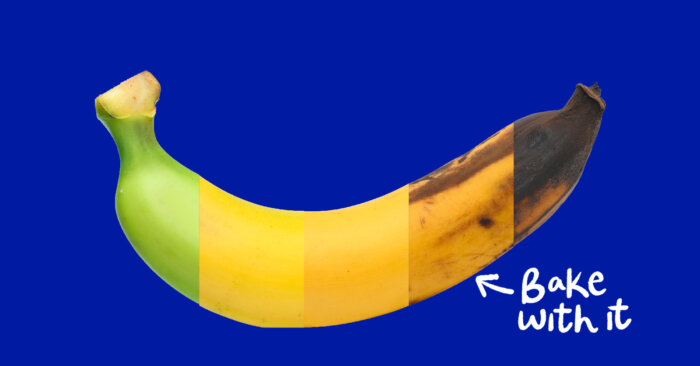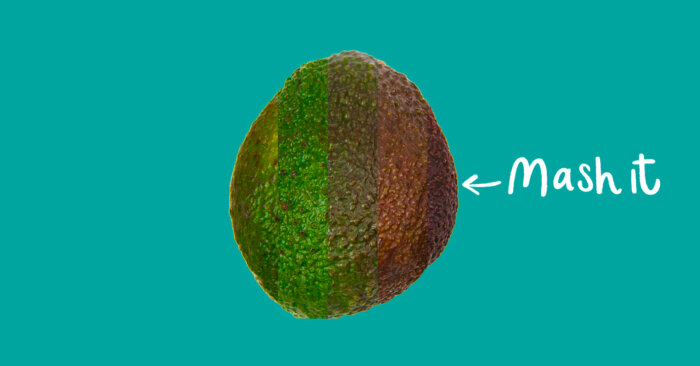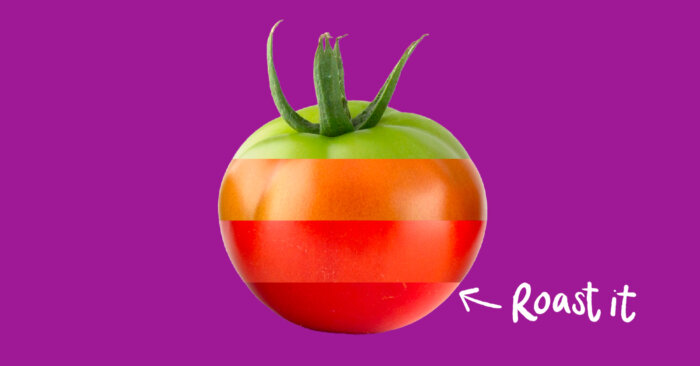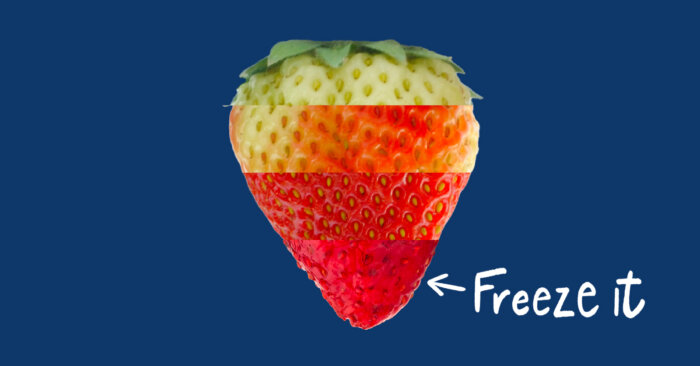WANT EVEN MORE HEALTHY IDEAS FROM SHAPE YOUR FUTURE?
Who doesn’t love strolling the aisles of the produce section looking at beautiful seasonal fruits and veggies? However, fruits and veggies sometimes have a mind of their own, and if you don’t know how to buy, store and serve produce at the perfect time, it can lead to food waste and be pricey. We all know the disappointment of peeling an underripe banana or tossing overripe produce in the garbage.
Here are five fruits and veggies you can use after they turn a little brown.

Bananas
Bananas are affordable, easy to pack and easy to eat! Bananas are best stored at room temperature on the counter or in your fruit bowl. Their thick skin makes them a great on-the-go snack for picnics, breakfasts and lunchboxes; however, their peel can start to show their age pretty quickly.
Ripeness indicator: Underripe bananas have a green hue to their skin, are tough to peel, frail and flavorless. If you buy a bushel of green bananas and you need to speed up their life cycle, break up the bunch so they mature a bit faster. A ready-to-eat banana will have vibrant yellow skin with just a few brown speckles. If they ripen too quickly, extend their shelf life by a day or two by refrigerating them. As bananas age, they will grow sweeter and softer!
How to use your overripe fruit: As bananas age, they’ll start to turn brown and become fragrant. You’ll smell a banana past its prime from all the way across the kitchen. However, instead of tossing the overripe fruit in the garbage, try these tips:
- Bake with it! Overripe bananas are perfect for baked goods like banana bread, pancakes and healthier ice cream. The sweetness packs a perfect punch of flavor and will have you coming back for more!
- Blend it! The creamy texture of bananas adds a thicker texture to smoothies and frozen treats.
- Freeze it! Peeled bananas can live in the freezer for up to three months. Keep them on hand for smoothie packs or as emergency baking supplies!

Avocados
Avocados can be heartbreaking. You can spend days waiting for the soft flesh to ripen only to see a brown mush on the inside. We know the feeling.
Ripeness indicator: There are two good tricks to test an avocado before you slice it. First, give it a squeeze. If the avocado is firm, it’s not ready to eat. An underripe avocado doesn’t spread easily and lacks flavor. You want the avocado skin to give a little under pressure; however, if it squeezes like putty, it’s past due.
The second avocado test is under the stem. It you look closely and see a vibrant green, then you’re good to cut! Quick tip: If you only use half an avocado, store the leftover half with the pit in it to keep it fresher longer! If the avocado is squishy and brown, it’s probably too ripe to use.
How to use your overripe vegetable: If your avocado is a little mushier than you would like, try a few of these tips before you throw it out:
- Mash it! If your avocado is a day or two past its peak, it’s probably the perfect consistency for guacamole and other dips. A few brown specks are fine, just scrape them off before you mash your avocado.
- Mix it! Did you know avocados make great additions to dessert? It’s true! The mild taste blends into the background and the texture elevates dishes like mousse, pudding and other yummy dessert recipes, like these truffles.

Tomatoes
Tomatoes are a versatile fruit that often gets confused as a vegetable, though we don’t recommend adding it to fruit salads. Tomatoes are best stored at room temperature and away from direct sunlight.
Ripeness indicator: If you’re trying to pick the perfect tomato, look for deep red colors that are soft to the touch and fragrant when you hold them close to your nose. Overripe tomatoes will start to feel squishy and wrinkly. However, a tomato hasn’t “gone bad” until it starts to grow mold. If you have a wrinkly tomato on your counter, look for white or green patches of fuzz before you start cooking.
How to use your overripe vegetable: Once you’ve checked for mold, head to the stove. While ripe tomatoes are perfect for sandwiches and salads, this overripe vegetable is better for cooking. Here are a few ways to use it:
- Roast it! Sheet pan veggies pair well with almost every meal. Chop your tomato up, spread it out on a sheet pan with other veggies and roast them up.
- Blend it! Overripe tomatoes are extremely juicy, making them perfect for pasta sauce and soups. Chop up your tomatoes and cook them down for a rich and flavorful base.

Berries
Strawberries. Blueberries. Raspberries. Blackberries. We love them all! Berries are nature’s healthy candy — but when these sweet, bite-sized treats turn a few days old, that flavor quickly turns sour.
Ripeness indicator: Ripe berries are vibrant in color, plump with juices and smell sweet. To keep them in peak eating condition, store them in the refrigerator and wash them just before you eat. Washing too early can cause berries to grow mold, leak and quickly turn into a mushy mess.
How to use your overripe fruit: Those mushy berries shouldn’t go to waste, though. If you have an abundance of this overripe fruit, there are plenty of uses — just be sure to toss berries that are a little fuzzy. Here’s how to use up your berries:
- Cook them! Overripe berries are great when cooked into jams, preserves and sauces, like this blueberry compote. Adding small amounts of sugar and lemon juice can turn your berries into a tasty topping or spread that you can store in the fridge.
- Freeze them! If your berries are on the edge, drain the excess juices and pop them in the freezer. Frozen berries are perfect for smoothies and baked goods.
Stone fruits
Stone fruits like peaches, plums and apricots are deliciously juicy and versatile. Store them on your counter or in your fruit bowl until they reach the perfect ripeness, then pop them in the freezer to slow the process.
Ripeness indicator: Ripe stone fruits yield slightly to pressure and have strong aromas. However, if a gentle squeeze dents your stone fruit, then it’s probably too ripe to eat on its own. You can also look for bruises or brown spots before you take a bite.
How to use your overripe fruit: The good news is you can trim away the bruises to make your overripe fruit usable. Here are a few peachy-keen tips:
- Grill them! You read that right. Grilled peaches, plums and apricots add flavor to every outdoor barbecue.
- Freeze them! You can toss whole stone fruits in the freezer for up to six months to use in baked goods and other recipes. If you want a sweet treat, add them to popsicles!
Other Produce:
- Potatoes: If your potatoes are sprouting buds, just cut them off before using. Overripe potatoes are best for mashing and roasting.
- Carrots: If your carrots are a little soft, soak them in cold water to revive them, or cook them into a soup or sauté.
- Leafy Greens: Wilted greens may not be ideal for salads, but they are perfect for stews, pastas and casseroles.
Don’t let the possibility of overripe fruits and veggies deter you from picking up produce. If you know how to enjoy them and how to store them, you can cut down on food waste for good!
Hungry for more tasty recipes? Head to our recipe site at MyShapeYourFutureOK.com to find your next favorite.




